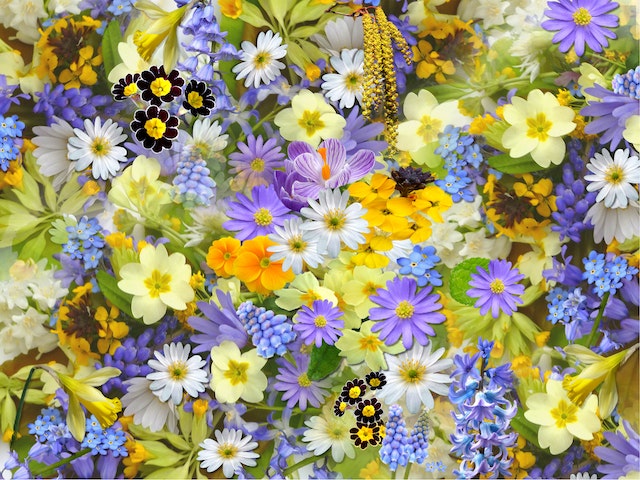
Why are flowers different colors? Because they have evolved to attract different types of animals and insects.
Flowers need insects and animals for two reasons: to pollinate them and to spread their seeds. Most plants need to be pollinated so that they can reproduce. Plants have a male part, called the stamen, that produces pollen. For a plant to be able to reproduce, that pollen needs to reach the ovary. The majority of plants pass their pollen to another plant because self-pollinating plants run the risk of genetic mutations, in the same way that inbreeding in any species can cause. There is more genetic diversity in non-familial reproduction. Some plants rely on the wind or other methods to pollinate, but 80% of plants use insects or animals to pass their pollen.
Plants also need a way to get their seeds as far away from them as possible. Very few plants want their seeds to grow right next to them because this would create competition for resources. They can scatter their seeds with wind again, or other methods, but a lot of plants use animals to spread their seeds.
What makes flowers the colors that they are? All flowers have pigments in them, which give them their colors. The more pigmentation they have, the darker they are. Reversely, the fewer pigments they have, the lighter they are. White flowers have no pigments. Different pigments produce different colors. Carotene produces yellow, orange, and brown. Chlorophyll produces green. Cyanidin produces dark red and pink. Pelargonidin produces bright red and orange. Delphinidin produces blue and violet. Different combinations of the pigments can make other colors as well. We often use these pigments to make dyes for clothes.
So, why are flowers different colors? Different animals and insects see colors in different ways and are attracted to different colors.
Beetles are attracted to flowers that are white or green. Not many people think that beetles are pollinators, but they are. They eat the flowers and carry the pollen away. They like flowers with a heavy scent.
Butterflies are attracted to flowers that are red, yellow, orange, pink, and purple. They like flowers with a flat top of lots of flowers clustered together. They suck out the nectar with a long proboscis and get covered in pollen.
Bees are attracted to white, yellow, purple, and blue flowers. Their eyes work from the wavelength of light that is yellow (about 550 nanometers) down through purple and into the ultraviolet band. They cannot see reds. Bees get covered in pollen when they crawl into the flower to get the nectar.
Moths are attracted to white or dull-colored flowers. Moths are mostly moving at night when color is not so important. Surprisingly (at least for me), there are several species of flower that open at night to cater to moths.
Ants are also pollinators. They can see colors in a similar range to bees, along with being able to see ultraviolet. They tend to go for flowers that are close to the ground with a short stem.
Some birds, such as hummingbirds, are also pollinators. Birds tend to be attracted to red, yellow, and orange flowers. The birds’ feathers get covered in pollen and they carry it to the next flower.
Most of the beetles and insects are attracted to scents, so flowers that aim at them will have a strong scent. Birds don’t have a good sense of smell, so flowers that aim at birds usually don’t have much of a scent.
Plants that don’t disperse their seeds via the wind usually do so by getting an animal to eat them as a fruit. Fruits are also different colors for the same reason as the flowers: to attract different animals.
Birds go for reds, so most berries are red, and also small so that birds can eat them. Mammals can see more colors than birds, but not as many as we can. Fruits tend to be a color that stands out from the background behind it, such as reds or yellows. Some animals, such as lemur, cannot see reds and greens, so the fruit they eat are yellow. However, animals tend to use their sense af smell as much, if not more than, their sense of sight, so a lot of fruit has a very strong scent when it is ripe. And this is what I learned today.
Sources
https://www.loc.gov/everyday-mysteries/botany/item/what-causes-flowers-to-have-different-colors/
https://www.fs.usda.gov/wildflowers/pollinators/importance.shtml
https://letstalkscience.ca/educational-resources/backgrounders/plant-reproduction
https://www.nwf.org/Garden-for-Wildlife/Wildlife/Attracting-Butterflies
https://www.ecrotek.com.au/blogs/articles/bee-friendly-blooms
